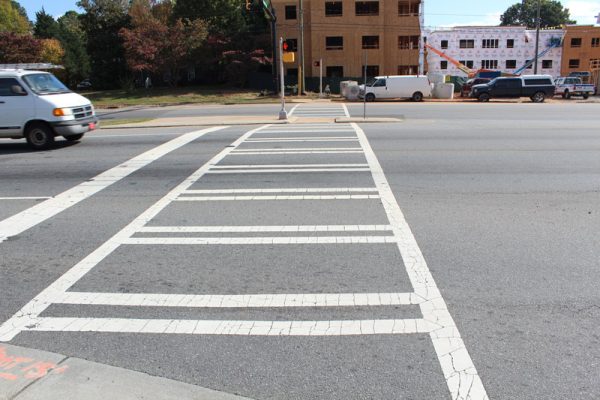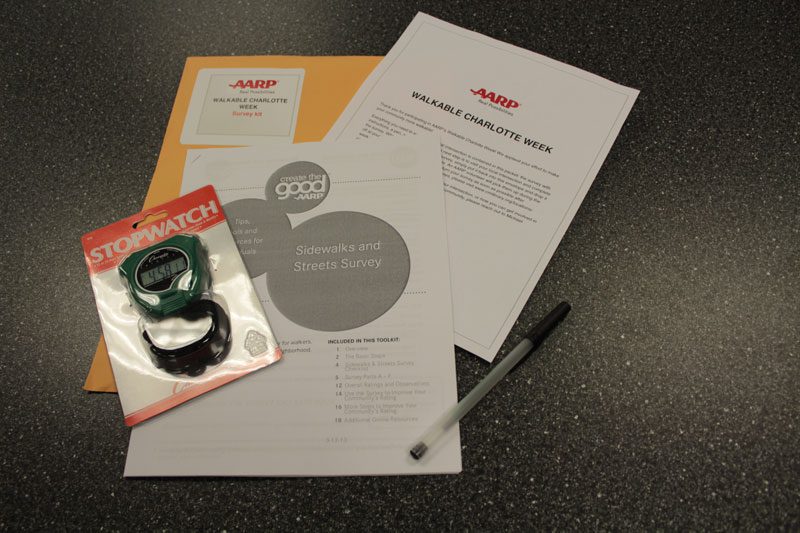Volunteers survey Charlotte walkability

Baby boomers are not waiting around for someone to help them cross the street. The local organization of AARP sent out volunteers to assess how well some Charlotte intersections treat pedestrians, including those of AARP-membership age.
As part of AARP Walkable Charlotte Week, about two dozen volunteers, armed with stop watches and digital cameras, evaluated 15 of Charlotte’s 750 signaled intersections around the city.
Where they surveyedMonday
Tuesday
Wednesday
Thursday
Friday
|
Why? According to the Charlotte Department of Transportation, since 2007 the city has averaged 315 collisions between pedestrians and motor vehicles a year. That includes an average of 12 deaths per year.
Michael Olender, AARP associate state director, stressed the importance of walkability for older people. “Communities have to be walkable because it allows people to be connected,” he said, “to do everything from transportation to local shopping to other services that they need.”
A 2011 national report by the advocacy group Transportation for America says that by age 75, only 69 percent of people will still be driving. The report, Aging in Place, Stuck without Options (download full report here), highlights the importance of pedestrian issues for the elderly and says walking is the second largest mode of transportation for older adults. The report also ranked the Charlotte-Gastonia-Rock Hill metro area as eighth worst among metros of 1 million to 3 million for the percentage of seniors without good access to public transportation. The Raleigh-Durham-Chapel Hill metro was fifth; Greensboro-Winston-Salem-High Point was sixth.
It’s not just access that’s a problem. Safety is also a concern. Those 65 and older make up 12.6 percent of the population. Between 2000 and 2007, this age group made up 22 percent of the nation’s pedestrian fatalities.
Transportation for America ranked the Charlotte metro area the 17th most dangerous metro areas for pedestrians, out of 52. (Download the 2011 report, Dangerous By Design: Solving the Epidemic of Preventable Pedestrian Deaths, here.)
Some areas of Charlotte are very walkable, CDOT transportation planning manager Dan Gallagher said, “while others are not so much.”
One of the biggest issues in Charlotte is the lack of sidewalks, Olender said. “Unlike many other parts of the country where there are sidewalks everywhere, there are many neighborhoods throughout the city that don’t have any.”
Charlotte is working to design streets and roads for multiple modes of transit, Gallagher said. “As we have to build new roads or improve existing ones, we are definitely taking a complete street design approach.” “Complete streets” is a design philosophy that considers pedestrian and cyclist needs as well as auto traffic when building or improving streets.
The AARP hopes to shine a spotlight on access and safety issues, raising public awareness and alerting decision-makers to the problems.
Olender said his organization will present the surveys to the CDOT. The AARP could also bring up specific problems in meetings with elected officials, he said.
 The AARP survey kits, called “Create the Good Sidewalks and Streets Survey,” were available at Charlotte Mecklenburg libraries. The kits included instructions, a stopwatch and a pen. Surveyors timed how long it took to cross the street or how long the walk sign is on, if there is no timer. The survey also encouraged participants to take pictures of potential hazards.
The AARP survey kits, called “Create the Good Sidewalks and Streets Survey,” were available at Charlotte Mecklenburg libraries. The kits included instructions, a stopwatch and a pen. Surveyors timed how long it took to cross the street or how long the walk sign is on, if there is no timer. The survey also encouraged participants to take pictures of potential hazards.
Olender said, “All somebody really needs is an intersection in mind and a quick visit over to their local library, and they can participate.”
Corey Conner wrote is article while interning at the UNC Charlotte Urban Institute in 2014 as a student at UNC Charlotte.
Corey Conner